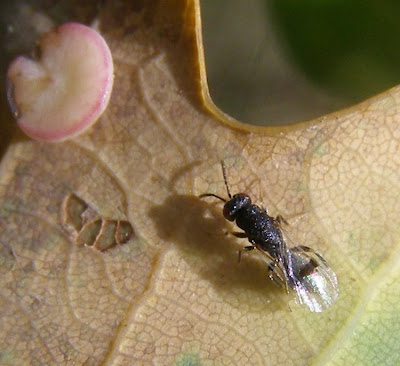
This afternoon I came across this black chalcid wasp on the underside of an oak leaf. I think it is probably Sycophila biguttata (Hymenoptea Eurytomidae) based on comparison with photos here and here. The black bar visible across the folded wings is actually formed by two black spots, one on each wing. Although I did see this specimen crawl over the smooth spangle gall visible in the top left of the above photo, Neuroterus albipes, the Cynipid wasp that causes smooth spangle galls, is not listed as one of the species parasitized by Sycophila biguttata. Maybe the above association was just a coincidence.
This individual was a female; you can make out a short ovipositor in the following photo:

Photos taken in Whiteknights Park, Reading University grounds, Reading, Uk, on 2009-11-02.
 Fri 2009-11-06
Fri 2009-11-06 
